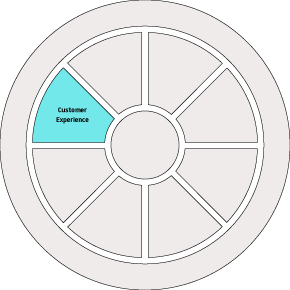CRM implementation - what does success look like?
 Customer Relationship Management (CRM) offers a dynamic approach for creating and developing customers, to fuel overall business growth. But like any initiative with significant benefits, it takes expert marketing project management to implement and embed within an organisation. CIM Board member, Neil Woodward, looks at the how to implement CRM successfully so that you can realise all the benefits of CRM, from automation efficiencies to long term customer loyalty.
Customer Relationship Management (CRM) offers a dynamic approach for creating and developing customers, to fuel overall business growth. But like any initiative with significant benefits, it takes expert marketing project management to implement and embed within an organisation. CIM Board member, Neil Woodward, looks at the how to implement CRM successfully so that you can realise all the benefits of CRM, from automation efficiencies to long term customer loyalty.
Neil has helped SMEs and large enterprises, drawing upon the skills he gained through experience in multi-national organisations, managing the customer experience from the first interaction through to product/services obsolescence. He is currently director of a new start-up, as well as running his own specialist product standards consultancy practice, WTECS.
Neil Woodward
BEng MBA MCIM ![]() Connect
Connect
Face facts – people don’t like change!
Implementing any new system within an organisation is always a challenge. Often the challenge is not the system itself, but the process of implementing the change within the organisation. As a general rule of thumb it has to be accepted that most staff will resist change until they see the benefit.
 The key to implementing a CRM system is the change management task through each phase of the project; this part of the project is commonly overlooked, and staff not embracing the system is not considered. Implementing a CRM system is about a number of key tasks,
The key to implementing a CRM system is the change management task through each phase of the project; this part of the project is commonly overlooked, and staff not embracing the system is not considered. Implementing a CRM system is about a number of key tasks,
- Change Management – getting the organisational buy-in.
- Definition – defining the functionality required in each phase of the implementation.
- Implementation - Small achievable steps that include testing and rollout.
- Key milestones – Review at key phases with users
- Celebrate success – amongst both staff and customers
CRM systems can undertake many tasks for the business, from integration with other systems to full automation. Maintaining support for the project within the organisation is best achieved by getting early wins, implementing some of the simpler tasks first provides confidence in the system and allows the system to start being used on a daily basis. This provides staff familiarity with the system and an opportunity for them to have an input on how the system should operate to make the process efficient, rather than the system being imposed upon them, this has the added benefit of assisting in the change management process.
Change Management
It is imperative that the whole organisation is onside for the implementation of the new CRM system as it affects many areas of the business. This may be difficult, as many staff resist change until they can see the benefit i.e. that it will make their lives easier. Hence often a push / pull approach is required to convince the doubters that the new system will improve customer experience, streamline processes and provide automation for customer actions. The system must provide benefits for the organisation as well as the customer! As each phase is implemented, it is recommended to check if the doubters have been converted and if not, understand what concerns they still have and ensure that these are addressed.
Phase Definitions
It is important not to implement a full-functionality CRM system in one hit. Instead, expand it out to bite-size phases. Define the functionality of each phase of the project in sufficient detail; it is recommended that during the early phases, the system is implemented quickly, even in a basic form, so that the system is used daily with real data inputted. This has a number of benefits;
- Early results are seen – output for the time invested.
- Not seen as another long-term software project that never gets implemented.
- Staff exposure to system, allowing them to become part of the process for defining later phases (system buy-in).
- Easier to convert doubters with a running system.
It is not necessary or possible to define all phases in complete detail, but the overall system structure is important. The early phases should be clearly defined as this will dictate the major requirements of the system. The later phases should be about customisations and improvements where necessary, as this allows the users of the system to have the ability to influence how the system will operate in the future- subject to cost and time!
Implementation
Once the system phase definitions have been defined to meet the business and customer requirements, some important initial decisions need to be made;
- Hosted internally / externally?
- Users - desk bound / mobile users / both?
- Open Source system / Closed proprietary system.
- Self-implementation / Third party implementation.
- Staff training – internal / third party.
- Data extraction from existing systems / data import into CRM system
Although this list is not exhaustive, it provides some of the key decision that need to be made. Not all the decisions in the above list are particularly binding i.e. the hosting of the system can be simply changed from either internal or external without any major issues. The more important decisions are the type of system ‘Open Source’ vs. ‘Proprietary’, implementation and training.
The ‘Open Source’ vs. ‘Proprietary’ should be carefully considered as this decision can significantly define the success of the implementation both in time and cost.
Open Source Software (OSS): is developed, marketed and distributed by a community of individuals and is available for free. The source code can be viewed and downloaded by anyone and then modified to suit the individual's or organisation's needs.
Proprietary Software: is developed by a vendor who then typically charges a license fee for the right to use the software. The vendor or implementation partner will then provide help with implementation of the software as well as ongoing support.
Definitions from Cadogenic.
If the phase definitions requirements can easily be achieved using a proprietary system and there is no roadmap for major changes to the business or system structure, then a proprietary system should be equally considered with open source systems.
If the proprietary system does not fulfil the requirements “out-of-the-box” then the cost and time to change the system to meet the phase definitions can be considerable and system modifications are generally restricted to the proprietary software supplier. It is advisable to explore with the supplier the costs and delivery at an early stage for all specialised changes and how this will impact on future upgrades. This will prevent unforeseen overruns on cost and timescales later in the project. In this instance an Open Source system may provide a better solution, as the changes can be undertaken with a range of suppliers, the software architecture normally has been designed for modification, hence a more cost effective and quicker solution is generally achieved.
System implementation, this decision is straightforward; does the existing staff have the time capacity and skill set to implement in the time frame required? If the honest answer to both of these questions is a definite ‘yes’, then self-implementation is a sensible option, otherwise get a third party to undertake the implementation and remove the pressure internally.
The training requirements should not be under estimated, it takes time for staff to learn new software and some staff will pick the system up quicker than others. Consider how the training will be achieved and who will be the system champion for the organisation. If the skill set does not exist internally to effectively train staff, then employ a third party to undertake the training and required documentation.
Key Milestones
Setting key milestones that are achievable in the project is important. It allows the organisation to see where the progress has been made and if additional support internally / externally is required to keep the project on track. It provides a review of the phase(s) implemented and staff can assess if elements defined in future phases need to be pulled forward from an organisational efficiency position, or additional elements to be included in future phases, that had not been considered at the project inception.
Celebration of success
It is important when key milestones are reached that these successes are celebrated both internally and externally. Internally, this maintains the morale for the upheaval and potential additional workload for staff. While externally, advising customers that new systems have been implemented to improve customer service.
Interested in more on CRM?
Catch up on Neil’s previous CRM articles for the London region:
Are your web communications a big let down?’
Have you managed to differentiate your business?
 Book the CRM training course that’s pitched at your level of expertise
Book the CRM training course that’s pitched at your level of expertise
- Introductory: 1 June 2015 in London Foundations of Relationship Marketing - How to build relationships with customers and increase their value to your organisation.
- Advanced: 7 - 8 May 2015 at Moor Hall in Berkshire Implementing a CRM Communications Programme - Learn how to build a CRM strategy and implement an effective communications programme
- Masterclass: 10-12 August 2015 at Moor Hall in Berkshire CRM 2.0 Successful CRM in a Connected World - Engage customers in an increasingly social and technologically-oriented marketing environment
Join our ‘CIM Community - London’ on LinkedIn and share your views on CRM or join the conversation on twitter @CIMInfo_London using #CRMsystems

